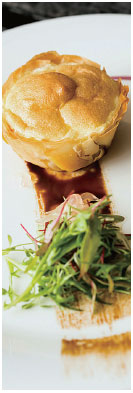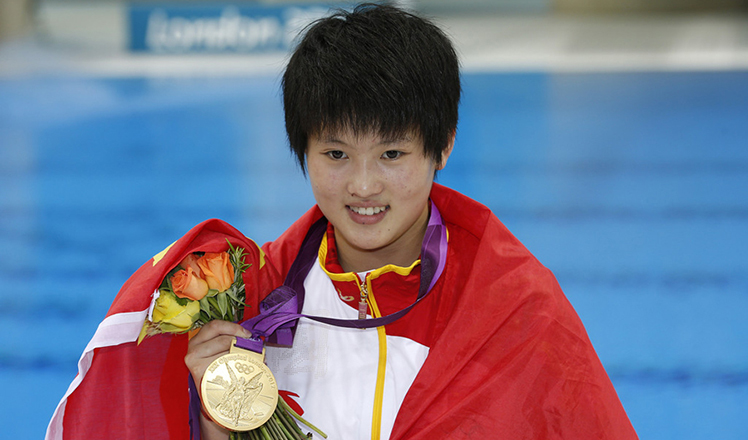Shelling out the goodness
Updated: 2016-10-21 10:45
By Xu Junqian in Shanghai(China Daily USA)
|
|||||||||
A look at the history of hairy crab cuisine and how some chefs from Shanghai have showcased their culinary creativity using this coveted autumn delicacy

Zheng Xianchao arrives at the renowned Wang Bao He restaurant before seven in the morning and spends the next two hours selecting 1,000 hairy crabs from the back of a black van, flanked only by his shifu.
The pair only picks females crabs that weigh more 100 grams and male ones that are over 150 grams. Anything lighter would be frowned upon by the customers of the time-honored restaurant that specializes in the autumn delicacy.
After transporting the crabs to the 272-year-old restaurant, Zheng spends another three hours tirelessly tying each squirming crustacean with blades of boiled lemongrass. The entire space, thanks to the scent of the plant, smells more like a spa than a kitchen.
This has been Zheng's daily routine during hairy crab season for the past 10 years. The way he binds the crab's claws and feet together is down to muscle memory.
"I think I have dealt with more crabs than one could possibly eat in his life," laughed Zheng before using his teeth to pull on a blade of lemongrass wrapped around a crab.
The unusually high rainfall and flooding in east China this summer has resulted in a lower than expected hairy crab harvest this year. Crab output at Yangcheng Lake, the most famous production ground in China that spans more than 2,000 hectares, has dropped by 15 percent.
The price of these coveted crustaceans have as a result hit its highest in a decade at around 150 yuan ($22) for a male and female pairing, equivalent to the minimum daily wage in Shanghai, according to the Yangcheng Lake Crab Industry Association.
Not that anyone at Wang Bao He is particularly concerned. They know customers will still flock to the establishment regardless of the price hike.
"Up or down, people who can afford it will always come and pay for it. It's like the real estate market in Shanghai - people always complain but they will still buy properties," said Wu, one of the kitchen staff at Wang Bao He.
The 54-year-old, who first started out as a dishwasher at the restaurant, has been around for even longer than Zheng. Today, she and seven other employees are expertly extracting the flesh and roe from boiled hairy crabs.
Wu and her colleagues produce about 300 grams of roe and flesh for every kilogram of crabs. The sweet and tender flesh is featured in the some 50 crabs dishes that are prepared at the other end of the kitchen by chef Wang Hao.
Founded in 1744 by a man from Shaoxing, Zhejiang province, who believed that the yellow wine from his hometown should be savored by more people, Wang Bao He has over the past two centuries built itself a reputation for being the "ancestor of yellow wine".
Historical records showed that the restaurant had as early as the 1930s been offering customers boiled hairy crabs as a food pairing with its famed yellow wine, which in China is somewhat equivalent to oyster and champagne in France.

However, it was not until the 1980s when the country reopened its door to the world that hairy crabs, like other luxury items, became available again. This was the time when the restaurant made the hairy crab a regular item on the menu and created 10 dishes dedicated to it, soon earning itself the title of "the ancestors of wine and the king of crabs."
"We are the first in China to offer a crab feast," claimed chef Wang, who started his apprenticeship at the restaurant in 1981.
Following Wang Bao He's success in incorporating hairy crabs into their menus, other similar dining establishments soon spawned. In 1991, Shanghai's Xin Guang restaurant became the first specialized hairy crab establishment in China. A decade later, Fujian native Ke Wei set up Cheng Long Hang which is today known as the largest hairy crab restaurant chain in the country.
The options for hairy crab lovers, however, are not limited to these few institutions. A quick search on Dianping.com, China's most popular dining directory, shows that there are hundreds of such restaurants in Shanghai. Even foreign companies have been quick to jump into the fray - Singapore's Paradise Group, among others, has introduced a special menu featuring four hairy crab dishes this year.
"The way people are enjoying crab dishes today is completely different from decades ago," said Wang.
"Before, people wanted a dish that featured the crab meat because most individuals could not afford having an entire crab to themselves. Today, diners want the same, but only because they don't have the time and patience to extract the meat themselves."
The most expensive dish in Wang's menu is a simple plate of stir-fried flesh extracted from three crabs that is packed into the shell of the crustacean. This dish costs 480 yuan per serving.
"You won't need vinegar for it. It tastes divine whether chilled or hot," said Wang.
The secret to this dish, he claims, is the lemongrass used to tie the crabs, the perilla that is added to the boiling water and the citrus juice added to the sauce.
"One of the things that discourage many people from eating the crabs, aside from the laborious dissection, is its muddy and at times fishy flavor. This is something we've been good at neutralizing," said Wang.
Over at Yong Yi Ting, the Chinese restaurant at Mandarin Oriental in Shanghai's Pudong district, chef Lu Yiming is busy creating his own crab feast. Yong Yi Ting was among the restaurants in Shanghai that were awarded a Michelin star this year.
The 34-year-old Shanghai native has been doing so every year since the restaurant opened in 2013 and his signature dishes are the steamed orange filled with hairy crab cream and yellow rice wine, and the baked crab meat souffl.
"I want the crabs to be in the dish, instead of on the dish," said Lu.
xujunqian@chinadaily.com.cn

 Ten photos from around China: Oct 14-20
Ten photos from around China: Oct 14-20
 Veterans mark 80th anniv. of end of Red Army's Long March
Veterans mark 80th anniv. of end of Red Army's Long March
 Road with 24 bends zigzags in Southwest China
Road with 24 bends zigzags in Southwest China
 Trump refuses to say he will accept election results
Trump refuses to say he will accept election results
 Top guns: Airshow China in past two decades
Top guns: Airshow China in past two decades
 Street photographer captures hustle-bustle of Beijing
Street photographer captures hustle-bustle of Beijing
 Five-time Olympic champion diver Chen Ruolin retires
Five-time Olympic champion diver Chen Ruolin retires
 Glimpse into lifestyle of astronauts in space
Glimpse into lifestyle of astronauts in space
Most Viewed
Editor's Picks

|

|

|

|

|

|
Today's Top News
'Zero Hunger Run' held in Rome
Trump outlines anti-terror plan, proposing extreme vetting for immigrants
Phelps puts spotlight on cupping
US launches airstrikes against IS targets in Libya's Sirte
Ministry slams US-Korean THAAD deployment
Two police officers shot at protest in Dallas
Abe's blame game reveals his policies failing to get results
Ending wildlife trafficking must be policy priority in Asia
US Weekly

|

|









